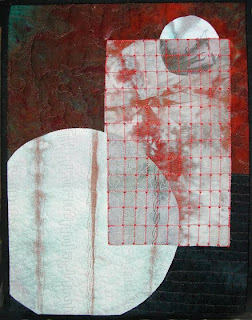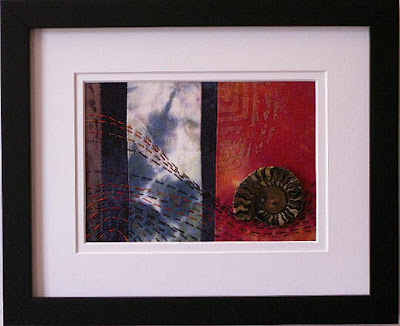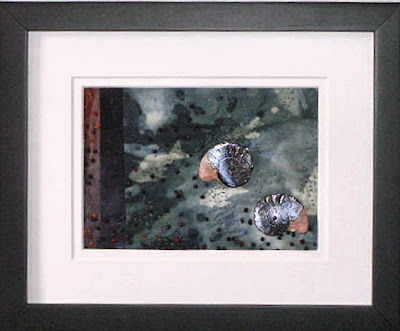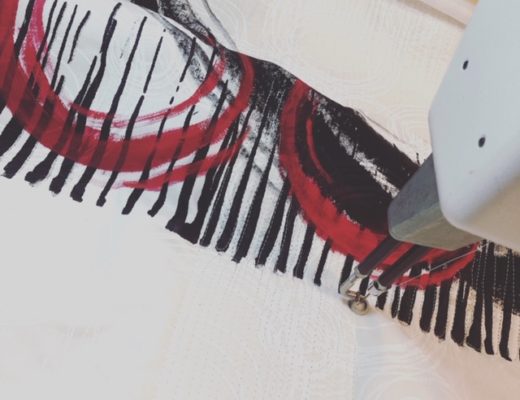I thought I’d continue the subject of showing your work by reposting an earlier series of articles. Be inspired! Enter your work and get it out into the world!
It takes a lot of courage to put your work in front of a judge or juror, or so I’ve been told. I’ve done it many a time and paid good money for the privilege. Why? Because I want people to see my work. Some artists might create their work entirely for their own pleasure, happy to let the art live in a closet forever, but I haven’t met them yet. Most of us have a message to send with our art – even if that message is as simple as “smile.”
Do I find it scary to submit to the jury process? No – but not because I think my art is great or because I always get into the show. This year I’ve been accepted to two out of four of the shows I’ve entered. Part of my “courage” is having seen enough jury processes that I know what is involved. Part of it is that I am able to emotionally let go of my work once it’s done. Let me explain.
In a juried show artists submit either images or the actual artwork, and a juror chooses which out of all the submissions will be in the actual exhibit. Jurors are usually professionals in the art field; established artists, gallery owners, professors, curators.
You fill out a form, you pay a fee. It’s not unreasonable. It costs money to advertise the show, to staff the exhibit, to pay the juror. Most of the shows I’ve worked with just barely break even.
What happens on the other end? Imaging receiving hundreds of files, some of which might actually have followed the guidelines in the prospectus. You’ve already answered what feels like hundreds of Email questions and helped people format their files or simply restated what is already written in the entry guidelines.
 All of the entries are now organized into a slide presentation and you have prepared numbered sheets for the jurors. The most common process that I’ve seen goes like this: A full and detail image for each entry is shown on the screen either side by side or one after the other. Most of the time the jurors will be shown a quick run through of all of the entries so that they can get an idea of what they are looking at. If the show has a theme the jurors might be told what it is and asked to find pieces that adhere to that unifying idea. Sometimes the jurors are given free reign to choose whatever pieces they think will make a wonderful exhibit. They will usually be told the number of artworks that can be accepted.
All of the entries are now organized into a slide presentation and you have prepared numbered sheets for the jurors. The most common process that I’ve seen goes like this: A full and detail image for each entry is shown on the screen either side by side or one after the other. Most of the time the jurors will be shown a quick run through of all of the entries so that they can get an idea of what they are looking at. If the show has a theme the jurors might be told what it is and asked to find pieces that adhere to that unifying idea. Sometimes the jurors are given free reign to choose whatever pieces they think will make a wonderful exhibit. They will usually be told the number of artworks that can be accepted.
The next run through is usually silent but takes more time. Each juror looks carefully at each piece and simply writes down “yes” or “no.” At the end of this run the jurors compare notes and any piece that has unanimous rejections are, well, rejected. Harsh? Not really. There are many, many reasons pieces are rejected that have nothing to do with the quality of that particular piece.
I’m sure the most frustrating reason for rejection is poor photography. When the jurors cannot see the artwork clearly it is impossible to judge it. Having anything at all showing in the background of the photograph is distracting. I remember one photograph in particular where the piece was pinned to a piece of bright purple foam core set on an easel. You could see half the living room and the jurors couldn’t tell if the purple was part of the quilt or not. Truly, if you present your work in the the most professional manner possible it will make a huge difference. Your work IS your best effort is it not?
Now things get difficult. After the rejected images are deleted from the pool the jurors once again view the pool, this time either meticulously rating each piece, or conversing with their colleagues to come to an agreement on the final selections. There is a good bit of cajoling, campaigning, and compromising that goes on here. Things get really interesting when you get more than one strong willed artist with an opinion in the room. I have yet to see anything but good manners and a willingness to work together in the best interests of putting on the best show possible.
Reasons for rejection at this stage? Numerous. The theme could be “Trees” and they reject the artwork depicting fishes and candy canes. The pool of entries might lean towards abstract and one photo-realistic piece, no matter how spectacular, just isn’t going to create a cohesive show. Perhaps these particular jurors love politically challenging pieces whereas another set of jurors might shy away from them. The venue for the exhibit might also issue guidelines regarding things such as nudity if children frequent the site.
You see, it really is simply the luck of the draw. There are so many factors that go in to the process that there really is no guarantee that you will be accepted into a show even if your work is truly wonderful. There are things you can do to raise your chances of being accepted.
1 – Research the show – what type of artwork has been exhibited in past shows?
2 – Research the juror – find out what other shows the juror has put together and what they look like.
3 – Take the best possible photographs of your work possible. Neutral backgrounds. Good light. Focused!
4 – Follow the instructions on the prospectus to the letter! Do not expect the organizers to resize your images or accept late entries.
5 – Stop worrying about it and just enter the show if you feel your work fits. Let your babies grow up and go out into the world.
Here is a short list of articles and a book that can help you with the tasks above.
 Shoot That Quilt by Andy Baird and Holly Knott
Shoot That Quilt by Andy Baird and Holly Knott
A wonderful tutorial on how to digitally photograph your quilt including plans for building your own nifty light stands. Yes, it can be done!
Digital Essentials by Gloria Hansen
This wonderful book clearly explains how to prepare your digital files for entry.
A list of art-quilt shows to enter compiled by yours truly
Listed by entry date, includes title, website/prospectus, show dates and shipping windows.
And finally – cut the apron strings. Let your babies grow up and venture out into the world on their own. Make enough work that all your hopes and dreams are not riding on one piece. Put your heart and soul into the work while you are creating it and then release it. A rejection of your work from a show is NOT the same as a rejection of you as an artist.
Look for more on this topic over the next week or two. I’d love to hear your experiences, opinions, and suggestions. Have you been involved in a jury process that worked differently? How do you think it can be improved?
Other essays in this series
Showing Your Work: choose your audience
Showing Your Work: choosing venues
Showing Your Work: fine craft shows
Showing Your Work: traveling trunk show
Showing Your Work: a museum experience
Showing Your Work: local venues
Showing Your Work: photographing your art
Showing Your Work: organizing entries
Showing Your Work: judged vs. juried
Showing Your Work: the jury process










26 Comments
patty
May 4, 2016 at 1:48 pmIf the jurors can’t handle the work load than they need to step down.
Lyric
May 8, 2016 at 6:13 pmWhat was there in this piece that made you assume the jurors couldn’t handle the work? They are paid a pittance for a job that is very difficult to do. I highly encourage you to volunteer for a local art group, or for SAQA or at minimum – at a local quilt show. Get involved and be part of the behind-the-scenes process. There are many people who put a call for entry together, write the prospectus, figure out the parameters of the venue and the theme of the show, figure out what rules make sense, do all sorts of mounds of paper/computer work to get everything ready to jury, write the acceptance and rejection letters (NOT an easy job!). Once you watch how things actually work the light dawns – you understand that rejection is not necessarily a judgement on the quality of your work most of the time.
Jeanne Marklin
March 1, 2014 at 9:43 amGood post with very helpful information and links. I’ve enjoyed reading your thoughts on exhibiting in the last few posts. I love getting acceptance letters, rejections don’t bother me anymore, but I wish there was an easier way to ship work. Between paying the jury fee and for the shipping and materials, it feels like an expensive venture. But I do love sending my babies out into the world as you say!
Sarah Ann Smith has an excellent blog post about setting up the camera for photographing work which builds on Holly’s great information. Here’s the link to Sarah’s post: http://www.sarahannsmith.com/weblog/
lyric
October 15, 2012 at 11:08 pmAlison – point well taken about wordage. “consider” is a much better word than judge. In a perfect world we’d get lots of good feedback about why any piece did or did not get into a show. Even in the small shows I’ve been involved in – there are just too many pieces interred for the juror to be able to give comments to everyone. And – what would they say? Great work of art but your fish didn’t fit with all of the birds in the show?
The juried art world is simply a whole different world than the quilt-show world.
I think the best thing to do would be to have a trusted group of artists to get together for a critique once in a while. Nothing is better than a fresh eye and a good evaluation to help you see where improvement is needed in your work.
alison schwabe
October 15, 2012 at 2:40 pmThoughtful and comprehensive, Lyric. I think beginners in this world will find it helpful. I only take issue with your choice of words where you say without good photography the jurors can’t ‘judge’ your work – perhaps you might have better used ‘consider’ ;-p you probably already know how I feel about how those words are used. And I think the hardest thing for newcomers to the world of juried shows is that they get no feedback on why their work was not selected. But lets be honest, quite often makers coming from a traditional background often assume if their latest art quilt is beautifully made, it should get in – but unfortunately there is a lot of poorly designed but technically terrific work out there.
Showing Your Work: part 2 – rejection | Lyric Art
October 10, 2012 at 6:00 am[…] like a failure? I discussed the jury process and the many reasons work is rejected from shows in my last post on this topic in case you missed it. What being rejected does NOT mean is that you are a failure as […]
Byrd
October 8, 2012 at 12:00 pmThank you so much for this piece. You present such this critical information in such a straightforward manner – I learned so much without intimidation. Take care, Byrd.
lyric
March 11, 2010 at 2:27 amGerrie has a great little explanation of the jury process she just went through if you all want to look.
http://www.gericondesigns.com/weblog/?p=5630
Jamie Fingal
March 8, 2010 at 7:55 pmI do find this interesting and have enjoyed reading your opinion. What comes to mind for me is that I think it might be a little more involved than that. Yes, bad photography is an issue.But in jurying a show – what if all of the photos are good? Part 2 comes into play -good design, color, and contrast? To be able to see the full quilt, with the edges being visible and the detail shot. If there is a theme, does the work and the statement relate to it? And the bottom line is do all the pieces make a cohesive exhibit? How do they all stack up together?
Tracie Lyn Huskamp
March 8, 2010 at 3:19 pmLyric I love this post… very informative and helpful. I have never tried entering juried exhibits. But I might get brave and try one of these days.
quilthexle
March 8, 2010 at 12:32 pmThank you so much for your post – I really appreciate that you took the time to put it all together in one blog post. I will for sure come back to it. And I just ***hope*** that some great quilter that are afraid of entering shows because they simply don't know what to expect – that they just give it a try. How many stunning quilts never get shown – and how wonderful it would be when we all could admire those beauties !
Lisa
March 8, 2010 at 6:25 amWOW! I finally got a chance to read the article at HollyKnott.com about shooting your quilt that you recommended and I am amazed at how much I have to work on. No wonder I've had such trouble with the way the photos turn out. I'm so excited that the problems seem to be pretty easy to fix too! I'll let you know when I get my first great quilt photos up!
Deborah Younglao, Silk Painter
March 8, 2010 at 2:40 amThanks for the insider's view! It's so important for us not to take rejections personally, as hard as that may be. I've had the same paintings that were rejected from one show, win awards in others. You just gotta keep on submitting.
Jean M. Judd
March 7, 2010 at 3:53 amGreat article, Lyric. Definitely filled in the blanks for artists who are just getting started in submitting.
Another tip I was given is to submit early, don't wait till the end as your image will also end up at the end of the viewing and by then jurors can be overwhelmed by everything they have seen previously. Also if there are problems with your entry (corrupted or damaged disk in transit) there isn't enough time for them to contact you and you to fix the error.
Suzanne Thompson
March 6, 2010 at 8:54 pmYour post is so well-written and helpful; thank you. I've just sent my first entry for a juried show and I have no clue how it will turn out. I submitted good photos, followed the rules and researched the venue. I'll do more research on past shows in the future. I suppose all I can do now is cross my fingers.
Elizabeth Rosenberg
March 6, 2010 at 3:34 pmWonderful article, Lyric. Thank you for the work that obviously went into it! It's so true that perfectly wonderful art can be rejected because it just doesn't "fit" into the show's theme. That's a hard pill to swallow when you are the artist who sends in that one lonely abstract!
I also want to thank you for all the hard work you do to keep an updated list of shows. Please know that your work does not go unnoticed, and is very appreciated!
Gloria
March 6, 2010 at 6:35 amGood article, Lyric.
I have a lot of experience with rejections. I've never been accepted to a Quilt National nor a Visions show. Not ever. I've received some nice notes saying "close," but close?? At one point I almost felt like giving up altogether. But I can be incredibly persistent, that is until I don't care.
I've entered the AQS show since it started. The first couple of years I didn't make the show. In the 25th annual show, I won a top award. Can you imagine? 25 years!!! I'm very honored the quilt is now in the National Quilt Museum, but 25 years!
Thanks or the mention of my book. I appreciate it.
Linda Robertus
March 6, 2010 at 4:22 amThanks for this very very useful post, Lyric!
Jane LaFazio
March 6, 2010 at 1:04 amthanks Lyric. I've entered lots of juried exhibitions and I just never know if I'll be accepted. It so depends on the juror, as you said, and the look of the other work. I always make absolutely sure my photography and framing are totally professional because I know, like you mentioned, how important that is.
thanks!!
Melly Testa
March 6, 2010 at 12:18 amWow Lyric, great explanation. I was a juror once and this explains the process so well. Some submissions were great, but compared to others they didn't look cohesive or comparatively solid. But they were still so good! It was a really difficult place to be, especially since the community I lived in was small and many local shows gave special opportunity to local participants. This show was juried nationally, so all the work needed to uphold one another and be cohesive as a whole. It is tough to curate and juror a show. I am happy to have had the experience in light of sending my own images and money off.
The images you posted were fantastic. Great post
Lynn Weathers
March 5, 2010 at 11:23 pmThanks Lyric! This is great information. I'm going to pass this along to some of my "show entering" friends. I've entered a few shows over the last couple of year, but just feel too overwhelmed with my real job to think about entering something right now.
Approachable Art
March 5, 2010 at 9:55 pmLyric, this is a fantastic article, thank you for sharing it. I'm only now dipping my toe in those juried waters and it's scary for it to be such an unknown for me. This article helps a LOT to explain the way things work behind the scenes.
Jackie
March 5, 2010 at 9:10 pmlove it! after having 2 rejections this year… and not prepared for both getting rejected. I looked back and one was definitely photography. On my part, bad. So after crawling into a hole for a day, I dusted off my ego and entered another show right away and am still waiting.
norma
March 5, 2010 at 8:54 pmVery thoughtful informative essay, Lyric. And I, too, enjoyed the images.
Lisa
March 5, 2010 at 6:55 pmThis is one of the best posts I've ever read because it is so thorough. I learned a lot and I love that you included other resources – especially how to build a light stand to shoot the quilt. I have problems shooting my quilts so that when I crop the photo it is square. Either the top or the bottom ends up bigger than the other end so I am anxious to see what I can do to make this right. I really needed this article last week but I know it will help in the future also. Thank you so much! (Oh and Loved seeing your work too!)
Diana Trout {Nan.DT@verizon.net}
March 5, 2010 at 6:34 pmThanks for this post, Lyric! I have to admit that I never do juried shows anymore. Many reasons, of course. I just prefer to show with small groups (for free 😉
I did learn a lot about the jurying process and show/venue process over the years and liked your sum-up.
I REALLY LOVE the images in this post. Fab.
Notice: Undefined variable: consent in /home/lyricki/public_html/wp-content/themes/hawthorn/comments.php on line 49